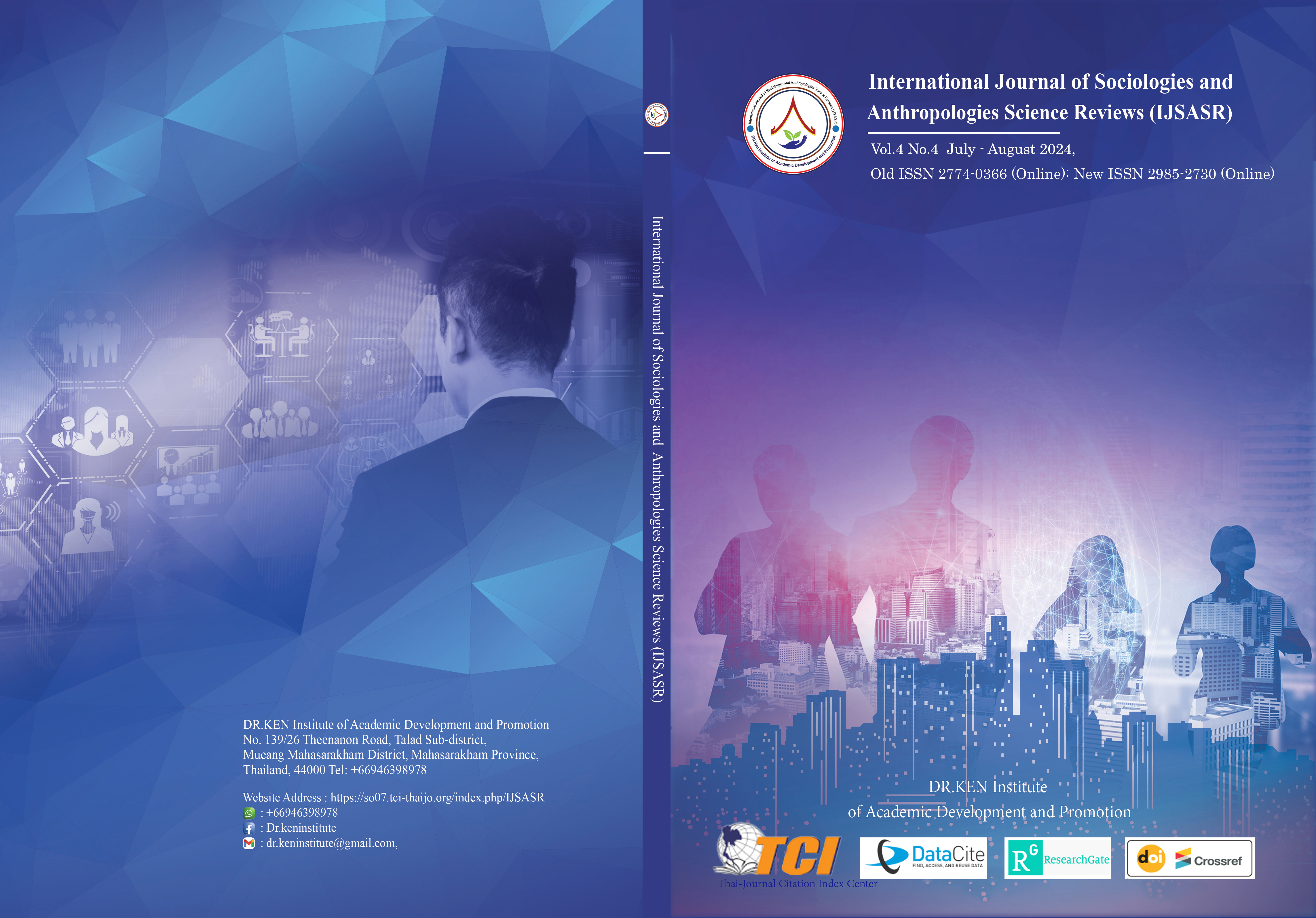Cultural Identity of Guangdong Lion Dance in Chinese Intangible Cultural Heritage Through Anthropological Perspectives
Main Article Content
Abstract
Background and Aims: This study delves into the cultural identity of the Guangdong Lion Dance within the context of Chinese intangible cultural heritage, employing anthropological perspectives to unravel its significance and impact. The aim is to explore and analyze the Guangdong Lion dance's cultural identity in intangible Chinese cultural heritage through anthropological perspectives.
Materials and Methods: Employing qualitative approaches, including surveys, interviews, and thematic analysis. A structured interview was designed to gather data on participants' demographics, exposure to the Lion Dance, perceptions of cultural identity, and attitudes toward intangible cultural heritage preservation. Participant selection involved recruiting individuals from Guangdong communities with diverse backgrounds, ensuring representation across age groups, genders, and socio-economic statuses.
Results: Reveal the deep historical roots and cultural significance of the Guangdong Lion Dance, highlighting its role as a symbolic representation of auspiciousness, prosperity, and communal unity. Despite facing challenges such as modernization and commercialization, the Lion Dance remains adaptable and relevant in contemporary contexts, showcasing its dynamic evolution and enduring resonance within Chinese cultural heritage.
Conclusion: This study contributes valuable insights into the complexities surrounding the Guangdong Lion Dance's cultural identity, emphasizing the need for sustainable preservation strategies, enhanced community engagement, and education initiatives. A significant Chinese intangible cultural heritage requires enhanced preservation efforts through collaboration with local authorities, institutions, scholars, and practitioners and global awareness through cultural exchange programs.
Article Details

This work is licensed under a Creative Commons Attribution-NonCommercial-NoDerivatives 4.0 International License.
Copyright on any article in the International Journal of Sociologies and Anthropologies Science Reviews is retained by the author(s) under the under the Creative Commons Attribution-NonCommercial-NoDerivatives 4.0 International License. Permission to use text, content, images, etc. of publication. Any user to read, download, copy, distribute, print, search, or link to the full texts of articles, crawl them for indexing, pass them as data to software, or use them for any other lawful purpose. But do not use it for commercial use or with the intent to benefit any business.

References
Aristidou, A., Shamir, A., & Chrysanthou, Y. (2019). Digital dance ethnography: Organizing large dance collections. Journal on Computing and Cultural Heritage (JOCCH), 12(4), 1-27. https://doi.org/10.1145/3344383
Avaunt, C. (2016). "Getting the Greens:" Relationships Between Lion Dancers and Economic Ideologies Within the Asian Garden Mall. Doctoral dissertation: UC Riverside.
Bakeer, M. (2023). Dancing Through Mythological Threads: Unraveling the Symbolism of Chechen Dance. Sakarya İletişim, 3(1), 55-74.
Chang, S.M.L., & Frederiksen, L.E. (2016). Chinese dance: In the vast land and beyond. Wesleyan University Press.
Chen, X. (2019). Challenges in preserving intangible cultural heritage amidst modernization pressures. International Journal of Heritage Studies, 25(1), 41-56. https://doi.org/10.1080/13527258.2018.1481415
Gingrich, A. (2017). A man for all seasons: An anthropological perspective on public representation and cultural politics of the Austrian Freedom Party. In The Haider Phenomenon (pp. 67-94). Routledge.
Guo, Y., & Karin, K. (2024). An Anthropological Analysis of He Peng's Works and Transmission in Bayin Zuochang National Music Art Education. International Journal of Sociologies and Anthropologies Science Reviews, 4(2), 327-342. https://doi.org/10.60027/ijsasr.2024.3994
Han, Q., & Sensai, P. (2024). The Development Process of Qinghai Mongolian Folk Songs Through Anthropological Perspectives. International Journal of Sociologies and Anthropologies Science Reviews, 4(2), 467-476. https://doi.org/10.60027/ijsasr.2024.4148
Kamkankaew, P., Meesubthong, C., & Sawang, K. (2023). Decoding, Connecting and Converting Cultural Understanding and Consumer Behavior: The Imperative of Applying Anthropology in Marketing Management. International Journal of Sociologies and Anthropologies Science Reviews, 3(6), 1-26. https://doi.org/10.60027/ijsasr.2023.3341
Liu, T. S. (2023). Reconnecting to the great civilization: The strategy of revitalizing the Hakka unicorn dance in Hong Kong's Hang Hau through the intangible cultural heritage system. China Perspectives, 134, 79-88. https://doi.org/10.4000/chinaperspectives.15895
Liu, Y. (2019). Unraveling historical narratives through anthropological approaches: Insights from traditional dance research. Cultural Anthropology, 34(4), 161-177. https://doi.org/10.14507/CA.2019.34.4.0102
Luo, Y.J., & Hsiao, P.W. (2023). Design of Interactive Learning Materials with Concept of Sustainability Integrated into Macau Drunken Dragon Dance. Engineering Proceedings, 38(1), 12. https://doi.org/10.3390/engproc2023038012
Madhavan, A., Fan, X., Fitzgerald, K., Gilliam, R., Lanki, C., Saeji, C. T., & Tuchman-Rosta, C. (2016). Dance in traditional Asian theatre. Routledge Handbook of Asian Theatre, 97-130.
McGuire, C. (2015). The Rhythm of Combat: Understanding the Role of Music in Performances of Traditional Chinese Martial Arts and Lion Dance. MUSICultures, 42(1), 2-23.
Su, Y. (2022). The Influence of Ancient Chinese Cultural Classics in Southeast Asia. In A Study on the Influence of Ancient Chinese Cultural Classics Abroad in the Twentieth Century (pp. 37-58). Singapore: Springer Singapore. https://doi.org/10.1007/978-981-16-7936-0_3
Sudan, Z., & Abdullah, W. J. I. B. W. (2024). Conveying Spirit Through Form: An Exploration on the Shape Symbols of Foshan Awakening Lion Head. Art and Society, 3(1), 89-100. https://doi.org/10.56397/AS.2024.02.08
UNESCO. (2017). Intangible cultural heritage. Retrieved from: https://ich.unesco.org/en/what-is-intangible-heritage-00003
Wei, S. (2023). Chaoshan Yingge Dance: Cultural Identity of Chinese Folk Dance in the Context of Modern China. Doctoral dissertation: Mahasarakham University.
Wong, S., et al. (2021). Symbolic meanings in traditional dance forms: A study of Guangdong Lion Dance. Journal of Cultural Heritage, 18(2), 231-245.
Xu, S.G., Zeng, Z.Q., & Chen, Y.H. (2017). Research on the Function of Dragon and Lion Dance under the Background of the National Fitness. DEStech Transactions on Social Science Education and Human Science. DOI: 10. https://doi.org/10.12783/dtssehs/eeres2016/7621
Yao, L., Sensai, P., & Junkate, K. (2023). Nurturing cultural engagement and learning among youth through Jingyun Dagu traditional Chinese folk songs in Tianjin Municipality: Cultural engagement and learning among youth. International Journal of Curriculum and Instruction, 15(3), 1845-1859.
Yao, M. (2012). Anthropological perspectives on cultural symbolism: A case study of traditional dances in China. Anthropology Today, 28(3), 156-169. https://doi.org/10.1111/j.1467-8322.2012.00869.x
Yap, J. (2017). The Art of Lion Dance (Vol. 1). Joey Yap Research Group.






